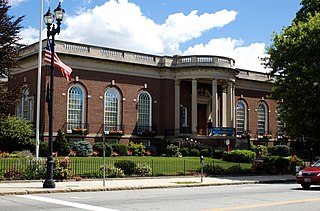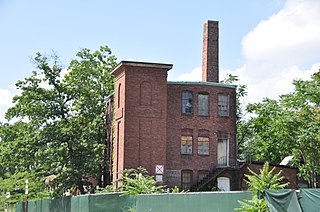
The Metropolitan State Hospital was an American public hospital for the mentally ill, on grounds that extended across parts of Waltham, Lexington, and Belmont, Massachusetts. Founded in 1927, it was at one time the largest and most modern facility of its type in Massachusetts. It was closed in January 1992 as a result of the state's cost-cutting policy of closing its mental hospitals and moving patients into private and community-based settings. The main complex of buildings has subsequently been redeveloped into apartments. The hospital campus was listed on the National Register of Historic Places 1994. The property also housed the Gaebler Children's Center for mentally ill youth.
This is a list of properties and historic districts in Waltham, Massachusetts, that are listed on the National Register of Historic Places.

The Beth Eden Baptist Church is a historic Baptist church building at 84 Maple Street in Waltham, Massachusetts. Built in 1891, it is a fine local example of Romanesque Revival architecture and is further notable as the oldest church on Waltham's South Side. The church was added to the National Historic Register of Historic Places in 1989. Its Settled Pastor is Rev. Dr. Esther Pearson.

The First Parish Church is a historic church at 50 Church Street in Waltham, Massachusetts, whose Unitarian Universalist congregation has a history dating to c. 1696. The current meeting house was built in 1933 after a fire destroyed the previous building on the same site. It is a Classical Revival structure designed by the nationally known Boston firm of Allen & Collens. The church building was listed on the National Register of Historic Places in 1989.

St. Mary's Roman Catholic Church Complex is a historic multi-building church complex at 133 School Street in Waltham, Massachusetts. Established as a parish in 1835, it is the city's oldest Roman Catholic establishment. Its 1858 Romanesque Revival church and 1872 Second Empire rectory are particularly fine architectural examples of their styles. The complex was listed on the National Register of Historic Places in 1989.

St. Charles Borromeo Church is a former parish of the Catholic Church in Waltham, Massachusetts. It is noted for its historic church building, completed in 1922. A high quality example of Italian Renaissance Revival architecture, it is emblematic of the shift on Waltham's south side from a predominantly Protestant population to one of greater diversity. The building was listed on the National Register of Historic Places in 1989.

The Waltham Gas and Electric Company Generating Plant is a historic power company generator building at 96 Pine Street in Waltham, Massachusetts. Built c. 1900–1909, this large concrete-and-stone building is an essentially unaltered early power generation plant, although all of its window openings have been filled with concrete. It originally housed a steam power generator, and was sold by Waltham Gas and Electric to Boston Edison, who converted it to an electrical substation in 1917, a role it continues to fulfill.

The U.S. Post Office—Waltham Main is a historic post office building in Waltham, Massachusetts. The T-shaped brick and stone building was built in 1935, as part of a Works Progress Administration project during the Great Depression. The Classical Revival building was designed by the Boston firm of Wadsworth, Hubbard & Smith. The interior is of a layout typical of other period post offices, with a central lobby area flanked by the postmaster's office on the left and a work area on the right. This public area is faced in a variety of stone products, predominantly marble from a variety of sources.

The Oxford is a historic multiunit residential building in Waltham, Massachusetts. The double triple decker apartment house was built in 1897, during the last major phase of development on the city's South Side, and is one of its only surviving houses of that type. It has well-preserved Colonial Revival features, including a dentillated and modillioned cornice. Its front entry is flanked by a pair of bowed window projections, and is sheltered by a portico supported by Tuscan columns.

The Castle, also known as Usen Castle, is a historic building at 415 South Street in Waltham, Massachusetts. The Medieval style structure, built in 1928 in the style of a Norman castle, stands on the campus of Brandeis University, where it served as a dormitory until 2017. The building, the design of which is unlike any other on the campus or in the city, was listed on the National Register of Historic Places in 1979.

The Stark Building is a historic commercial building in Waltham, Massachusetts. The three-story brick building was built in 1891 by John Stark Jr., the owner of a successful manufacturer of watchmaking tools. It is one of Waltham's few surviving and well-preserved Queen Anne commercial buildings, having only received significant alteration to its storefronts. The building was listed on the National Register of Historic Places in 1989.

The Waltham Water Works Shop is a historic municipal public works building at 92 Felton Street in Waltham, Massachusetts, United States. The two story brick building was built in 1894, as part of a major municipal construction campaign. It is distinctive as a well-preserved yet utilitarian municipal structure, whose construction embodies some significant advances for the period. Its basement level, which originally housed a workshop, had a cement floor and was illuminated by both gas and electrical fixtures, all then somewhat advanced features. The main floor, which housed offices, space for carriages, and stalls for six horses, was constructed of concrete and iron. The upper floor housed storage as well as hay and fodder for the stabled horses. By the 1980s the building had been readapted by the city for use as a dog pound.

The Central Square Historic District is a historic district encompassing the central town common of the city of Waltham, Massachusetts, and several commercial buildings facing the common or in its immediate vicinity. The common is bounded by Carter, Moody, Main, and Elm Streets; the district includes fourteen buildings, which are located on Main, Elm, Lexington, and Church Streets, on the north and east side of the common. The district was listed on the National Register of Historic Places in 1989.

The Waltham Public Library is the public library of the city of Waltham, Massachusetts. Its main location is in the Francis Buttrick Library, an architecturally significant Georgian Revival building built in 1915, funded by a bequest from Francis Buttrick, a major landowner in the city. The building was listed on the National Register of Historic Places in 1989.

The Piety Corner Historic District encompasses one of the oldest settled areas of Waltham, Massachusetts. It is centered on a major road intersection, the junction of Totten Pond Road with Lexington and Bacon Streets, and includes the city's largest single concentration of well-preserved 19th and early 20th-century houses. It extends south from Totten Pond Road along Bacon Street as far as Greenwood Lane, and along Lexington Street to Beaver Street. The district was listed on the National Register of Historic Places in 1990.

The O'Hara Waltham Dial factory was a historic building at 74 Rumford Avenue in Waltham, Massachusetts. The three-story brick structure was built in 1897 by Daniel O'Hara, and housed his company, a spinoff from the Waltham Watch Company which specialized in the manufacture of a variety of clock faces. The building had distinctive corner towers with paneled brick surfaces, although these were a later addition. O'Hara's company operated until the late 1950s; the facility was then used in the manufacture of traffic signals and luggage.

The Mt. Prospect School for Boys was a historic school at 90 Worcester Lane in Waltham, Massachusetts. It was a large Georgian Revival brick building built in 1923 to house an experimental boys' school. The school was founded by Arthur Astor Carey, and was headed by Hugo B. Seikel. The school only operated for about ten years, after which the property was converted for use as a nursing home.

The Harrington Block is a historic commercial and retail building at 376–390 Moody Street in Waltham, Massachusetts. The three-story brick building was built 1884-85 by Charles Harrington, a local real estate speculator who was also employed by the Boston Manufacturing Company. It is one of the city's few Queen Anne commercial building, and is the oldest commercial building on Moody Street to escape major alteration. The ground floor originally housed retail establishments, while the upper floors were residential.

The Daniel French School is a historic school building at 38–40 Common Street in Waltham, Massachusetts. Built in 1847 by a prominent local educator, it is a well-preserved example of vernacular Greek Revival architecture, and is important for the role it played in Waltham's 19th century educational environment. The building was listed on the National Register of Historic Places in 1989. It is now a residential duplex.

The Eastern Middlesex County Second District Court is a historic courthouse of the Massachusetts District Court at 38 Linden Street in Waltham, Massachusetts. Built in 1938-40, it is one of three Art Deco buildings in the city, and its most fully realized example of the style. The building was listed on the National Register of Historic Places in 1989.






















